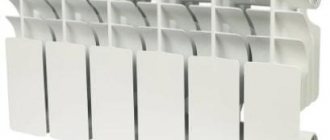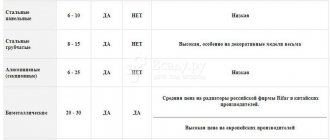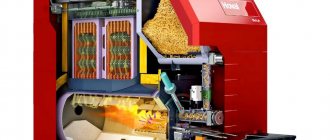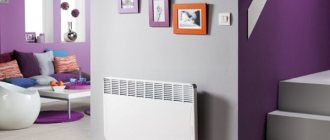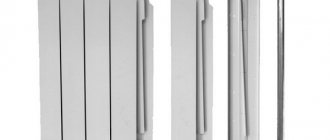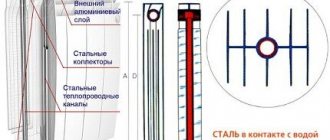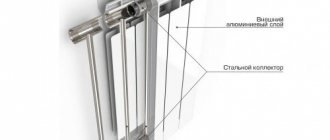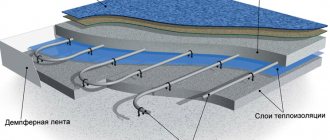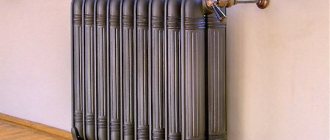Bimetallic radiators are a type of battery that is made of different metals: internal channels are made of stainless steel, the external heat exchange body is made of aluminum. Stainless steel is resistant to aggressive coolant environments. Aluminum has excellent thermal conductivity and heats up quickly. There are sectional and monolithic structures. Used in central and autonomous heating systems.
When studying the huge range of batteries for heating rooms offered on the Russian heating engineering market, the consumer often has the question of which bimetallic heating radiator is best to choose for an apartment or private house.
The choice of bimetallic radiators is becoming increasingly important today. This happens because in one design of a heating device, the positive qualities of two metals - steel and aluminum - are used to the maximum.
This combination provides a number of advantages compared to devices made from the same material. The frame made of steel water pipes in an aluminum alloy shell is a bimetallic radiator, comparable in thermal power to aluminum and steel heating devices, and in reliability to cast iron radiators.
Which bimetallic heating radiators are best suited for each specific case must be determined individually. A suitable model is selected based on a number of criteria such as the type of bimetal, steel thickness, and thermal power.
The type of model and the calculated pressure are also important. In addition to technical characteristics, the choice of a particular device design is influenced by its cost and attractiveness of design.
The best companies of bimetallic radiators
There are quite a lot of companies with a good reputation on the heating equipment market, but not all of them can offer decent quality at an affordable price. We analyzed the products of more than 20 companies and selected the best among them in terms of quality, design, and energy efficiency. As a result, the rating included products from the following 7 brands:
- Global - the history of this brand dates back to 1971, the company has grown from a small workshop into an industrial giant in the production of radiators. The key differences of its products are lightness, beautiful design, ease of installation and use. They are effective in systems with hot coolant. The surface of the structures is scratch-resistant and, thanks to high-quality painting, does not change its color even during long-term use.
- Rifar - bimetallic radiators of this brand are manufactured in Russia and have the optimal combination of price and quality. It is controlled at all stages of production, which ensures the strength, reliability, and efficiency of products. The company's product range includes both monolithic and sectional models. Some of them are offered in several sizes. They are distinguished by perfect sealing of the intersection connection, which minimizes coolant leakage. Their work remains effective at both high and low pressure.
- Rommer is one of the market leaders in sectional heating radiators, which are developed by Russian engineers using unique technologies. This company has its own factory, which is located in China. She takes a responsible approach to production, checking not only the finished product, but also each cast section individually. This allows you to eliminate or minimize the likelihood of marriage. Its products comply with international quality standards. Their collectors are steel and made of corrosion-resistant materials, which increases their service life.
- Sira is a leader in the production of radiators for heating houses and apartments. Its products are manufactured under strict control and meet all quality and safety requirements, which makes this company one of the best among manufacturers of bimetallic radiators. They are distinguished by low energy consumption and high performance characteristics. The company's products have innovative design, good strength and excellent corrosion resistance. When using it, there is almost never any extraneous noise, which makes their use comfortable. The structures here are made up of several sections and, if necessary, depending on the model, they can be added or subtracted immediately upon purchase.
- Lammin - brand products are developed using modern Finnish technologies and produced at the best factories in Russia and East Asia. The peculiarity of its products is that they are made from selected materials. They are distinguished by high-quality filling and a neat appearance, which is ensured by high-tech painting. Thanks to the durable coating, the products can withstand various negative factors.
- Royal Thermo is an industrial concern whose production facilities are located in Russia and Italy. It has been operating on the Russian market since 2002 and during this time has earned itself a good reputation. This is a full-cycle enterprise that independently develops technologies, thinks through the design and puts all this into practice. Its production is fully automated, but despite this, quality control is carried out at every stage. In particular, this is why Royal Thermo products comply with ISO 9001 and ISO 14001 standards.
- Radena - the company has a line of bimetallic radiators, made up of several sections, the number of which can reach twenty or more. On average, they can withstand temperatures up to 110 degrees and a working pressure of 25 atm. They are distinguished from the products of other companies by the minimum volume of coolant of 0.10-0.19 liters per section. The products are made in white and blend beautifully into any interior. They have the best price-quality ratio.
If you need something cheaper, then you should pay attention to the products of Radena, Royal Thermo, Rommer. In the assortment of other companies, the emphasis is on mid-price models and premium designs.
Repair of heating batteries in an apartment
The main question that arises when there are problems with heating in an apartment is where to go and who will pay for the repairs.
Since problems with radiators, especially outdated ones, happen frequently, so do legal “skirmishes” between residents and utility services. Representatives of the housing office each time claimed that they were in charge only of that part of the heating system that was located in the entrance, while the owners of the affected apartments proved the opposite.
This was the case until the law on communal property was adopted, according to which the entire heating system, even that located in private apartments, is under the jurisdiction of public utilities. The specialists of the organization that provides heat ensure that all radiators work efficiently , and the residents of the house contribute money monthly for major repairs of the heating system in an apartment building, if necessary.
The heating in the apartment is not working, who should I call? For any problems with the system, you need to call the appropriate service and its representatives will fix them free of charge.
This does not apply to cases where the heating is in order, and the residents decide to change the radiators to a newer model. In this case, the entire replacement occurs at the expense of the apartment owners.
When a heating radiator leaks in an apartment, this is caused by the following reasons:
- Their service life had long expired, and a breakthrough was only a matter of time.
- They could not withstand the pressure during the summer maintenance work. This may be due to the wrong choice of heating batteries.
To independently fix a broken heating battery in an apartment, which is usually not recommended, you can use epoxy resin-based glue, but only as a temporary solution to the problem until the emergency service arrives.
If the cause of the leak is a dried out gasket, then you can replace it yourself, provided that there is no water in the system. If the accident occurred during the heating season, then in order to avoid burns it is better not to do anything on your own.
As can be seen from the above, in order not to wait for extreme cases, you need to monitor the heating system, and if it does not heat, makes strange sounds or leaks, then you should call the housing office or emergency service.
If the radiators have long expired, there is no need to check them for durability, but replace them with a more modern model that matches the parameters.
netholodu.com
Rating of the best bimetallic radiators
When selecting nominees, we studied product characteristics and customer reviews. The winners were included in the rating based on the following parameters:
- Dimensions – height, width, thickness;
- Quality of materials and workmanship;
- Design;
- Available number of sections;
- Installation method;
- The volume of water required for normal operation of the heating system;
- Maximum permissible operating temperature;
- Resistance to pressure drops and its permissible upper limits;
- Focus on the heating system - modern or old-style;
- Corrosion protection;
- Product weight;
- Easy to install.
One of the most important criteria for selecting the best bimetallic heating radiators was the price-quality ratio, as well as the reputation of the manufacturing companies. We analyzed their availability on the market and the duration of the factory warranty.
Extrusion method
In this method, the heat exchange part is manufactured in an extruder under pressure, and the lower and upper manifolds are cast separately. All parts are then joined together by flaring, welding or pressing. In general, such radiators are not monolithic.
It is impossible to repair damaged components, as well as to increase or decrease the number of sections - everything must be calculated and before that, estimate what heat transfer and power you need.
In extreme conditions, such radiators do not work particularly well, therefore they are inferior in comparison with cast ones and are gradually being forced out of the market. But their price is much lower.
Which radiators are better - aluminum, cast iron or bimetallic?
Of course, the most durable are cast iron radiators, which last more than 30 years and even longer due to their resistance to pressure changes and the negative effects of low-quality coolant. They look like ordinary batteries. Aluminum and bimetallic models have a flat base and consist of several sections, the number of which, depending on the product, can be changed.
| View | Advantages | Flaws |
| Cast iron | Heats nearby objects | Gives off heat more slowly |
| Suitable for any type of heating system | Heavier | |
| Can easily withstand exposure to coolant of any quality | ||
| Aluminum | Affordable price | Less selection |
| Easy to install | Holds paint worse | |
| Large pressure resource | Corrosive instability | |
| Bimetallic | Not afraid of pressure surges | Requires water drainage for summer |
| Corrosion resistant | Not the thickest walls | |
| Light weight | Lasts less than cast iron |
Cast iron batteries have almost become obsolete in the form in which they were installed during the Soviet era. They are relevant mainly in rooms decorated in a “retro” style. In modern renovations, bimetallic or aluminum types are most often chosen, although the former are cheaper and more accessible.
The best steel radiators
From cast iron to aluminum and bimetal
The ancestor of modern radiators is the cast iron battery, which was invented and cast at his factory by our compatriot, Franz San Galli, a German of Italian origin, but with Russian citizenship. At that time, German water heating systems already existed, but it was San Galli who invented the cast iron radiator. At his instigation, the “Russian battery” in the form of thick pipes with vertical disks spread throughout the world, where they began to actively improve it. They came up with new forms and replaced cast iron with other metals until they invented the steel radiator. Aluminum radiators appeared a century later - in the sixties of the last century, in Italy, and a few years later they also developed a bimetallic structure.
Radiator made by San Galli
The best bimetallic radiators with side connections
This connection method is most common when it comes to older apartment buildings. In them, the pipe junction is most often done vertically between floors, combining into risers. In this case, the coolant is supplied to the upper pipe, and the outlet is to the lower. We analyzed 10 different models and, based on the highest energy efficiency, best quality and affordability, selected the 5 most worthy options.
Global Style 500
...The Global Style 500 radiator gives a good effect when heating even large rooms, but experience shows that its operation is affected by the distance from the window sill, floor and walls, which must be clearly adjusted...
Expert opinion
What makes this model the best bimetallic radiator for apartments and houses is its good heat transfer, which allows you to stay comfortably in the house even in the coldest season. This indicator became possible as a result of the large surface of the product and due to the use of aluminum.
The design is highly durable, due to which it can be mounted both with autonomous heating systems and with centralized ones. But still, there is a strict limitation on the working pressure - up to 35 atm. The manufacturer made it sectional, and this simplifies the installation process, since you can reduce or increase the number of sections at your discretion.
Advantages
- Good build quality;
- Simple design that fits easily into any interior;
- Does not corrode;
- Accurate size and shape;
- Creates a directed air-heat flow.
Flaws
- Do not use abrasive cleaners to care for the radiator.
- Automatic air valves are required.
Sira RS Bimetal 500
This bimetallic heating radiator was selected from the top 10 contenders, which could not match it in terms of economy and efficiency of use. Being made of steel and aluminum, it gives off a lot of heat and does not allow you to freeze even in cool rooms. True, for rooms from 20 sq. m. you need at least 5 sections, although there are no problems with this, since you can always order the required number, but at the same time it cannot exceed 20 pieces. According to reviews, the design heats up quickly due to the small volume of water (0.2 liters per section). Hang it on the wall and it easily fits under the window.
Advantages
- High quality workmanship;
- The maximum operating overpressure is 40 atmospheres;
- Large margin of safety;
- Resists well against hydraulic and any other loads;
- Beautiful painting, no yellowing;
- High degree of tightness.
Flaws
- Sometimes they crackle slightly.
Reviews of the Sira RS Bimetal 500 models indicate its neat dimensions, due to which it can be installed even in small rooms with low window sills.
Rifar Base 500×14
Rifar Base 500×14 is a budget bimetallic radiator designed for wall mounting. Because of this, it remains almost invisible to guests. The manufacturer offers 3 design options in different sizes, which allows you to choose the most suitable design taking into account the square footage of the room. At the same time, this is a standard structure, which includes 14 sections; the company does not offer to add or remove them.
The product weighs almost 27 kg, which may create some difficulties during installation and require outside assistance. Despite the thin fins, the design has an excellent margin of safety and retains heat well. Reviews show a neutral attitude towards the bright white color of the frame, which quickly becomes dirty. At the same time, you cannot clean the surface with anything.
Advantages
- Good heat dissipation;
- Beautiful design;
- Fast warm-up;
- Withstands pressure surges;
- Resistant to aggressive coolants.
Flaws
- Factory, standard equipment.
Reviews speak positively about the quality of Rifar Base 500×14 joints, so breakthroughs and floods are out of the question here, and time has virtually no effect on the strength of the products.
Rommer Profi Bm 350
This bimetallic radiator is the best representative of classic products. It has an optimal height of 415 mm and is easily placed even in small spaces. Thanks to its medium thickness, heat enters the room faster and is maintained at the proper level. Its use is safe, but still you should not exceed the pressure of 36 bar. The pipes are made of steel, famous for its excellent heat-conducting properties, but at the same time, in order to avoid corrosion, it is better not to leave water inside during the off-season.
Advantages
- Quick connection, side;
- Wide range of options for completing sections;
- Manufacturer's warranty;
- Withstands exposure to even low-quality water;
- High strength;
- Good coverage.
Flaws
- It is better to use with domestic heating systems.
The Rommer Profi Bm 350 model easily fits into any interior and does not distract attention from it due to its standard design and small size.
Lammin Eco BM-500-80
The peculiarity of this model is the possibility of its use in heating systems with both low and high quality coolant. The radiator performs well even where it is exposed to high pressure, up to 40 bar. This is slightly more than some of its peers from the rating.
It should also be noted that the paint is of decent quality, which lasts for many years. Unfortunately, here you cannot select the required number of sections; they are offered in 1, 4, 6, 8, 10 or 12. The walls of the product are quite strong and can withstand high pressure, and the steel from which the pipes are made does not deform.
Advantages
- Two-stage painting technology;
- Small volume of water in the section – 0.2 l;
- Large service area;
- Light weight of 12 kg;
- Warms well.
Flaws
- One height is 55.7 cm.
The best bimetallic radiators with bottom connection
This method of connecting to the heating system is quite rare. It is mainly used in private houses in which radiators are installed one behind the other. In this case, the coolant moves along the chain, but is not always distributed evenly. Because of this, some pipes may be warmer, others colder. To do this, a circulation pump is used here, creating a coolant current inside. We studied the available options and selected the best bimetallic radiators.
Rifar Monolit Ventil
This bimetallic radiator was included in the rating due to its optimal price-quality ratio. It is very “hardy” in terms of coolants; its sections can withstand water shocks of up to 150 bar. Reviews show that leaks are not detected due to well-designed joints. The heat transfer here is almost impeccable, so the temperature in the apartment or house is maintained at a good level even during prolonged use. But expect that one such design will heat an area of more than 30 square meters. m., no longer necessary.
The Rifar Monolit Ventil radiator has a beautiful white color and high-quality coating that can withstand moisture and other negative factors. What makes this option beneficial is that it is suitable for both new and old heating systems. To effectively heat the room, 0.21 liters per section is enough, which indicates high efficiency.
Advantages
- Factory warranty for 25 years;
- Nice design;
- Withstands temperatures up to 135 °C;
- Smooth surface;
- The optimal height is 57.7 cm;
- Cools down slowly;
- Weight 12 kg.
Flaws
- There is no possibility to add sections at your own discretion.
The delivery set includes everything necessary to connect the radiator - flow distributors, Mayevsky valve, plugs and valves.
Royal Thermo PianoForte Tower x 18
This is another design that has an original design due to the vertical arrangement of sections. The standard set includes 18 of them, which provides high heat capacity and allows you to quickly increase the air temperature even in large rooms. Such characteristics can be explained by the good, according to reviews, power of the bimetallic radiator of 2142 W and the small volume of the required coolant of 3.78 liters of water for the entire structure. It is connected at the bottom and the connection elements with the heating system are almost invisible from the outside.
Advantages
- Withstands temperatures up to 110 °C;
- The walls warm up quickly;
- Beautiful design;
- A simple method of eyeliner;
- Warms well.
Flaws
- Requires a lot of wall space due to the height of 1440 mm;
- Not a low price.
Radena VC 500
First of all, this bimetallic radiator differs from other models in the rating in its appearance. It has quite wide sections, due to which it was possible to reduce the cost of the design and not lose any heat transfer. It hangs on the wall and, with an average height of 55.2 cm, easily fits into any space, including under windows. One section holds 0.22 liters of water, and its quality is not particularly important here. Due to the fact that there is less of it in the heating system and it heats up almost instantly, the room becomes warmer much faster than at higher levels.
Advantages
- Maximum operating temperature – 110 °C;
- High quality parts;
- Good build;
- High-quality surface painting;
- Low sensitivity to sudden changes in pressure in the system.
Flaws
- Sold in at least 3 sections.
Causes of failure
If the heating system has failed not because of its “antiquity”, then you should look for a fault somewhere else.
It could be:
- The radiator does not match the system of the apartment building. This may be due to pressure or quality of the coolant.
- Flaws when connecting to pipes , which can cause a breakthrough after a while.
- Operating conditions are not suitable for this type of radiator due to frequent pressure changes.
- If the coolant is too littered , then this causes the accumulation of suspensions at the attachment points, which in due time will lead to a leak.
- Gaskets between sections also do not last forever , and failure of one of them can compromise the integrity of the system.
The main visual sign that something is wrong with the system is an obvious leak, while internal damage, for example, airiness or contamination, can be determined by the temperature in the room.
Which bimetallic radiators are best to buy?
Models with resistance to the chemical composition of the coolant in the range of 6.5-9 pH are considered a good choice. The weight of one section is usually 1.5-2 kg. The average heat transfer rate is 100-185 W. To operate effectively, the structure must withstand a pressure of at least 25 atmospheres. In a quality product, both the collectors and vertical tubes are made of steel. With a standard placement of window sills, you can choose a radiator with a height of about 0.5 m, but in the case of a lower location, models up to 0.35 cm will be needed.
Here is the best bimetallic radiator to buy, depending on the purpose:
- For use in old-style systems, Global Style 500 will be relevant.
- In small rooms you can get by with the Sira RS Bimetal 500 heating device.
- In houses where low-quality coolant is supplied to the pipes, you can use Rifar Base 500 x
- If heating systems often experience pressure surges, then you should pay special attention to the Rommer Profi Bm 350.
- If you need a radiator with very fast heating, then the Lammin Eco BM-500-80 has proven itself well.
- For heating areas of about 20 square meters. m. the model Rifar Monolit Ventil 500 x5 will be useful.
- For autonomous heating, you should consider choosing the Royal Thermo PianoForte Tower x 18.
- In small rooms you can install Radena VC 500.
By choosing the best bimetallic radiator, very soon you will notice how the house will become warmer. The rating presents only those models that have received many positive customer reviews and have been successfully tested in practice. There are both budget options and premium models, we hope everyone will find a suitable offer for themselves!
Why don't they warm up?
It is extremely unpleasant at the height of the winter season to face the fact that either the whole or part of the heating system is cold. To figure out why the heating radiator in the apartment does not heat, the reasons need to be looked for in what is preventing the flow of coolant into the system.
There are only a few of them:
- This can be facilitated by airing of the heating system in an apartment building , which can be detected either tactilely by probing the batteries in search of a cold area, or by the sound of the coolant, which is forced to “press” through the disturbed area.
- If there is not enough water in the system , this will lead to an air lock in the entire structure due to the lack of proper circulation.
- When the heating installation is old , then its “weak link” is congestion in the pipes. Over many years of operation, suspensions and rust settling on the bottom clog their narrowest part. This can also be detected tactilely.
- If the batteries were connected incorrectly , then they will remain cold, and only the pipes will be hot.
You can eliminate some of the reasons yourself, for example, remove the air lock.
The heating battery in the apartment has burst - what to do:
- If there is a circulation pump, it must be turned off to relieve excess pressure on the system.
- Open the Mayevsky tap , and if there is none, then remove the plugs from the battery .
- These actions will cause air to escape from the system , which occurs with a characteristic hissing sound.
- After water flows from an open tap, turn it off.
It is necessary to prepare containers for the coolant in advance and wait until the whistling from the system stops completely. After some time, you can check the radiators for the presence of heat - if they are hot, then everything is done correctly.
If the reason that the radiators do not heat is a lack of coolant, then such work should not be carried out independently, without having the appropriate experience. When water enters the system, air pockets can form. If the system is clogged, it should also be entrusted to the experts, since this will require removing it for cleaning or completely replacing its damaged areas.
